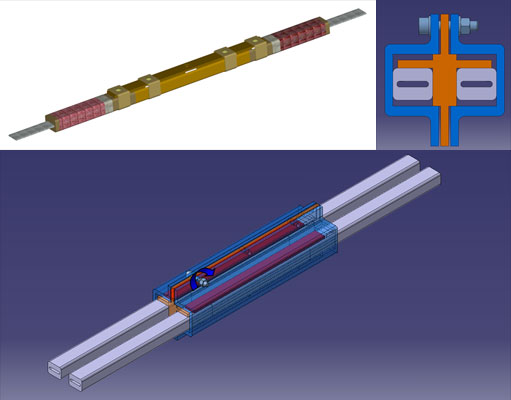
ATLAS e-News
23 February 2011
Outlook for 2010
22 February 2010

Schematics of the splice fixes
At the end of January, the LHC machine team, experiments, and CERN Management came together at the LHC Chamonix workshop to agree on a preliminary run plan for the next two years. The LHC will run for 18-24 months at a collision energy of 7 TeV, until the experiments have collected an integrated luminosity of 1 fb-1 of data.
There will be just one short technical stop midway through the run period and an extended shutdown of around one year will follow at the end, at which time the machine will be readied for running at its design energy of 14 TeV.
“Clearly we would have liked to have had 10 TeV as soon as possible, however there are a lot of studies and physics that we can do at 7 TeV,” says ATLAS Deputy Physics Co-ordinator Aleandro Nisati.
The option of a partial repair of the machine, enabling it to run at 10 TeV for a period, was ruled out at Chamonix. This would require warming up all eight sectors and fitting copper stabilisers to some magnet splices. Since further shutdowns and upgrade work would then be necessary to take the machine to design energy at a later date, the decision-makers favoured the option of an extended physics run at 7 TeV, ahead of a complete repair to 14 TeV capability.
During the long shutdown, all the magnet splices in the machine, which are intended to carry a current of up to 13 kA, will be upgraded with high quality copper shunts, and then clamped.
The planned run strategy should provide peak luminosities of about 1032 during 2010, and a total integrated luminosity of around 200 pb-1 of data is expected to be collected by November. Intensity and luminosity will be pushed in 2011, until the target of 1 fb-1 of data is reached.
“A long run now … gives the machine people the time necessary to prepare carefully for the work that’s needed before allowing 14 TeV. And for the experiments … enough data across all the potential discovery areas to firmly establish the LHC as the world’s foremost facility for high-energy particle physics,” said CERN’s Director of Accelerators and Technology, Steve Myers, in a public statement following the Chamonix meeting.
So what does this mean for ATLAS in terms of physics running? What can be done within these limits, and is the feeling about the decision positive or negative?
“It’s limiting our physics potential for the first two years of data taking, but not compromising it,” explains Aleandro. A long run at 7 TeV could provide a comparable amount of data to a short one at 10 TeV.
ATLAS will use the run to continue to study the physics performance of the apparatus, to hone the accuracy of the Monte Carlo simulation software that is crucial for understanding real data, and “prepare all we can for understanding of the background” which will save time in interpreting new physics, even when higher energy data becomes available.
A large 7 TeV sample is “scientifically interesting” and will certainly allow ATLAS to begin exploring beyond the Tevatron’s range. “First, we can expand our Minimum Bias understanding,” says Aleandro. This will be followed by studies of jet production, inclusive lepton production, and the creation of J/Ψ and Υ particles. “And then, with more and more luminosity, we can start observing of the production of W and Z bosons in this new energy domain.”
Truly novel physics is not off the agenda either: “Clearly we cannot look to Higgs searches in a very wide interval, but we have some sensitivity at 7 TeV. Also we cannot exclude a priori the appearance of unexpected signals from exotic physics and SUSY,” Aleandro points out.
The feeling amongst the physics groups seems to be sober but positive. “The decision to run at 7 TeV is a bit disappointing, but sound. Of course we want to discover the Higgs, and is it harder and slower at this energy, but it does finally allow us to start,” says Higgs working group co-convenor Bill Murray. Exotics working group co-convenor Cigdem Issever agrees:
“I think from the physics analysis point of view it is better to have stable running conditions than short runs with different settings. Every new setting will mean a period of inefficiency, so I am very happy that we will have a long run at 7 TeV. We can do a lot with this data already.”
 Ceri PerkinsATLAS e-News
|